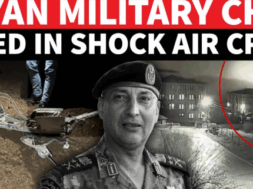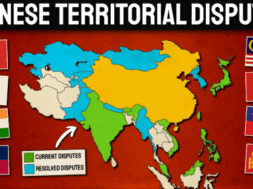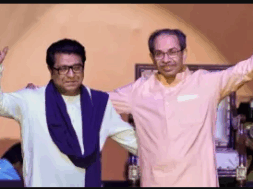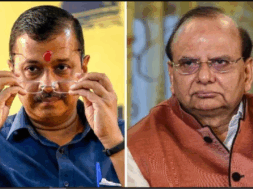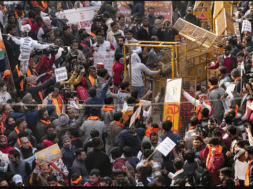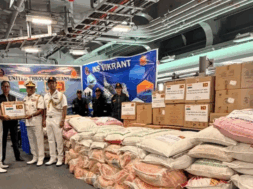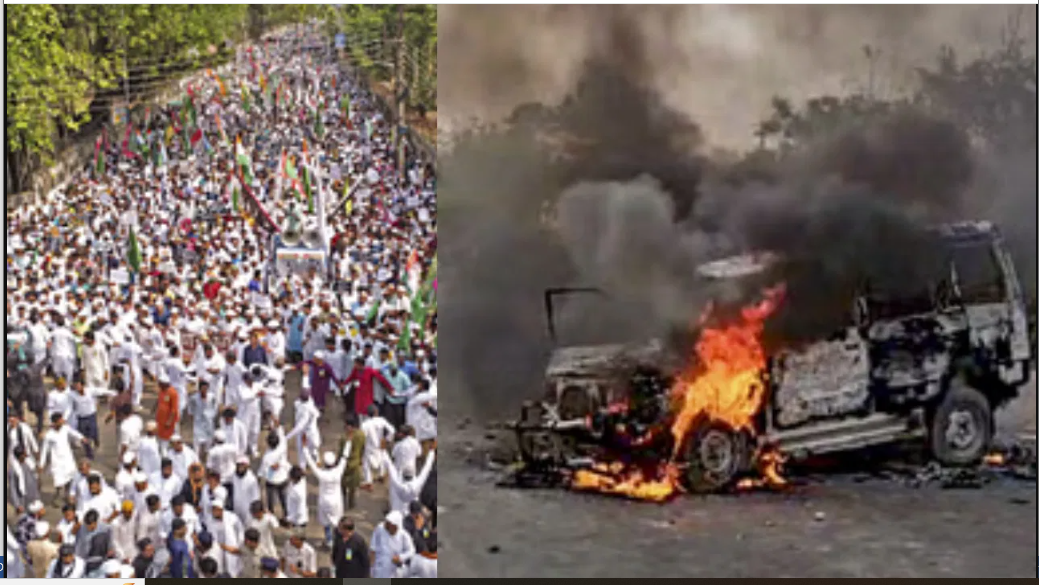
Centre Raises Concern over West Bengal Violence, State See Demographic Changes with Increasing Muslim Population
Manas Dasgupta
NEW DELHI, Apr 15: As several of the displaced families continue to express apprehensions about safe return to their houses across the river in Murshidabad district, the Centre on Tuesday raised concern over the recent violence in three border areas of West Bengal and has deployed additional paramilitary forces as a precautionary measure, official sources said.
The preliminary investigation into the violence indicated the involvement of Bangladeshi miscreants, allegedly supported by local TMC leaders, who subsequently lost control over these elements. The violence displaced Hindu families, forcing many to flee to across the Bhagirathi river to Malda, sparking fears of renewed infiltration and communal unrest.
The sources said the Centre sought clarification from the Mamata Banerjee-led state government regarding its “failure” to protect lives and property, the attack on railway assets, and police inaction during the initial stages of the violence. The BJP leaders have accused the TMC government of engineering communal tensions over the Waqf Bill to divert attention from the SSC recruitment scam, which has jeopardised the jobs of over 26,000 candidates. BJP leaders alleged that the violence highlights the deep-rooted insecurity of Hindus under the TMC rule.
The Calcutta High Court on Saturday ordered the deployment of Central Armed Forces in West Bengal’s Murshidabad, where protests against the Waqf Amendment Act spiralled into violence. The unrest, which erupted on April 12 and 13, 2025, in several parts of Murshidabad, including Suti, Dhulian, and Jangipur, was triggered by protests against the amended Waqf Act.
Several of the residents who have taken shelter in a school in Malda, are still shaken by the traumatic experience and want permanent central force camps in their areas. Khushbu Das, a resident of the violence-hit Dhuliyan area, said, “They (rioters) burnt down our grocery shop. They set fire inside our house. We kept calling the police and fire brigade, but no one picked up the calls. They looted our homes and misbehaved with the women. We want a permanent camp (of the BSF) here so that this does not happen again. We want to live here peacefully,” she said.
Prajakta Das, another Dhuliyan resident, said the situation was still frightening. “We want peace, security and a solution to this. We want a permanent camp of central forces here. Central forces visited this area and saw what happened here.”
Sitting inside a classroom on the first floor, Lalpur resident Pratima Mondol (30) echoed a series of events narrated by many others — cowering in fear as a mob ran riot. “The mob ransacked our home as we hid on the terrace. The next evening, we took a boat to cross the river. I have a one-year-old,” she said. “We couldn’t bring anything with us. Police and BSF will eventually be gone; who will protect us then?” said Namita Mondol (40), a resident of Sabjipatti in Dhulian, who is at the school with her 18-year-old son.
Inside the classrooms, benches have been removed to make room for bedding, and local villagers and the administration have made arrangements for clothes, food and medicine. The school is guarded by armed policemen and personnel of the Rapid Action Force.
Birendra Kumar Sharma, CRPF Inspector General for West Bengal, said the situation in the district was tense but under control. Eight CRPF companies, including 4 RAF companies, have been deployed in the area, he said.
Asked how the central forces’ deployment has helped the situation, he said, “There has been an increase in the people’s confidence. Wherever we have gone, they are asking the forces to establish their camps. We are establishing those camps,” he said.
The senior CRPF officer said the areas where they do not set up camps would be covered by patrolling. “We are conducting operations in consultation and coordination with the BSF and state police.”
Three people were killed and homes of many families vandalised in north Bengal’s Murshidabad. Many families were also forced to abandon their homes and flee to safety. Following the Calcutta High Court’s intervention, central forces took charge of the violence-hit areas. No fresh incident of violence has been reported in the past 48 hours as central forces and state cops keep vigil in Jangipur, Dhuliyan, Suti and Shamsherganj areas.
The violence in Murshidabad has sparked a massive political row in the state where Assembly polls are due next year. While the ruling Trinamool has accused the Opposition BJP of fomenting trouble, the BJP has hit back by saying that Mamata Banerjee’s “appeasement politics” has emboldened radical elements. A total of 210 people have been arrested so far in connection with the violence, officials have said.
Top intelligence sources have noted a substantial demographic shift in West Bengal, raising concerns about potential imbalances, migration issues, and crimes in the region. Following the 2021 election, violence and attacks on Hindu properties in districts like Murshidabad and Malda have driven many families to leave these areas.
In Muslim-majority regions, Hindu-owned businesses are allegedly experiencing boycotts, leading to asset sales at below-market rates. Muslim population growth is concentrated in border districts, reshaping local power structures and contributing to tensions and Hindu migration.
Muslim families in rural districts such as Murshidabad and Malda report higher birth rates. Intelligence officials say illegal immigration from Bangladesh, including Rohingya refugees, has significantly altered the demographics in border districts. The ruling TMC has been accused of vote-bank politics, with allegations suggesting that the settlement of migrants is being facilitated in exchange for electoral support. Benefits like stipends for imams and minority housing scholarships allegedly disproportionately favour Muslim communities.
Historically, post-Partition in 1947, the Muslim population in West Bengal was around 12%, with Hindus forming about 88%. According to the 2011 Census, Muslims constituted 27.01% of the state’s population (24.6 million), while Hindus were at 70.54%. By 2025, estimates suggest that Muslims may account for 30-33% of Bengal’s population (approximately 34 million) due to higher fertility rates, immigration, and socio-political factors.
Murshidabad had a Muslim population of 67% in 2011, which is expected to reach 70% by 2025. This increase is due to its proximity to Bangladesh, high fertility rates, and immigration from Rohingya communities. Malda, known for its agricultural hub, had a Muslim population of 51.27% in 2011, expected to reach 55% by 2025. North Dinajpur had a Muslim population of 49.72% in 2011, projected to rise to 53% by 2025 due to cross-border infiltration and government appeasement policies.
Birbhum had a Muslim population of 37.06% in 2011, which is expected to increase to 40% by 2025. South 24 Parganas had a Muslim population of 35.57% in 2011, expected to reach 38% by 2025, influenced by urban migration from Bangladesh and appeasement policies.
Uttar Dinajpur had a Muslim population of 49.92% in 2011, projected to rise to 52% by 2025, driven by illegal immigration and the migration of Hindus to Assam. Nadia had a Muslim population of 25.58% in 2011, expected to reach 28% by 2025, facing infiltration and increasing madrasa influence in border districts. Howrah had a Muslim population of 24.47% in 2011, projected to reach 27% by 2025. Kolkata had a Muslim population of 20.6% in 2011, expected to rise to 23% by 2025, with economic opportunities drawing Muslim labourers from rural areas.


